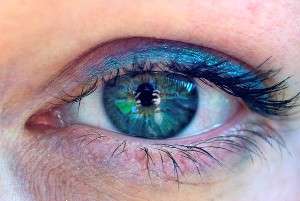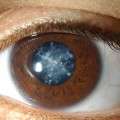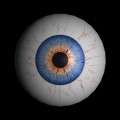AGE – RELATED MACULAR DEGENERATION (AMD)

What is ΑΜD
Age-related macular degeneration (AMD) is a serious eye disease whose prevalence increases with age. AMD is now the leading cause of untreatable vision loss and legal blindness in the United States, and will become even more so as our population gets older. The disease causes the macula (the pea-sized, central part of the light-sensitive retina) to deteriorate; this destroys the sharp, central vision needed for seeing objects clearly, and for common daily tasks such as reading and driving. Ten million American seniors (mostly women, because they live longer than do men) have some form of AMD.
Signs and Symptoms
In AMD’s early stages there are changes in the appearance of the retina, such as large yellow spots and changes in pigment (melanin) distribution, which can be seen by the doctor during a thorough eye examination through dilated pupils. In many people, the disease slowly progresses to either or both of two “late stages”, called “dry” and “wet”, both of which interfere severely with good vision. Neither form causes any pain. In the more-common dry form, the cells in and behind the macula slowly deteriorate, leading to a gradual loss of central vision. The most-noticed early sign of dry AMD is blurred vision. As fewer cells in the macula are able to function, people will see details less clearly in front of them, such as words in a book or faces. Often this blurred vision will, at first, go away in brighter light. If the loss of these light-sensing cells becomes great, people may see a small, but growing, blind spot in the middle of their field of vision. The dry form of AMD seldom leads to complete blindness.
The wet form, although it affects only about 10 percent of all people with severe AMD, accounts for 90 percent of legal blindness from the disease. In this form, new blood vessels grow behind the retina. Because these new vessels tend to be very fragile, they will often leak blood and fluid under the macula. This causes rapid damage to the the macula; it can lead to the loss of central vision in a short period of time. The classic early symptom of wet AMD is that straight lines appear crooked. This results when fluid from the leaking blood vessels gathers and lifts the macula, distorting vision. Your eye-care professional may suspect AMD if you are over age 60 and have had recent changes in your central vision. To look for signs of the disease, he or she will use eye drops to dilate, or enlarge, your pupils, in order to get a better view of the back of the eye. You may also be asked to view an amster grid, a pattern that looks like a checkerboard. Early changes in your central vision will cause the grid to appear distorted, a sign of AMD.. If there are signs that a blood vessel behind your retina is leaking, your eye doctor may inject a fluorescent dye solution into your bloodstream (through your arm) and trace the leak by taking photos of your retina; this is called flurosceine angiography.
Prevention of AMD
Smoking, diet, and genetics appear to be factors that contribute to the risk of getting AMD. Smoking greatly increases your chance of suffering from this disease. Therefore, quitting smoking (or, better yet, never starting) will lessen your risk of AMD. There is also some evidence that eating foods rich in carotenoids and vitamins may help prevent the disease; in any case, it is good advice to eat several portions of fruits and vegetables daily. Scientists are trying hard to find the genes responsible for a propensity toward AMD. This is not simple, because there are probably many genes involved, and because your lifestyle affects the course of the disease. If you know that close family members have had AMD, you should be more watchful for signs of it in your own eyes.
Treatment
There is no cure for AMD. Although no treatment now exists for the dry form of AMD, a recent study concluded that some vitamin/mineral supplements may be helpful in slowing the course of this form of AMD. Many cases of wet AMD can be treated with laser surgery, which involves aiming a strong light beam onto the fragile, new blood vessels (diagnosed through fluorescein angiography) to destroy them. Vision loss in wet AMD can best be slowed by a new laser treatment called photodynamic therapy, in which a photosensitizing drug such as verteporfin is injected into the patient’s arm just before the laser beam is applied to the eye. However, any vision that has been lost cannot be restored, and the patient will need to return for follow-up exams and, usually, for additional photodynamic therapy treatments. THE NEW AMD TREATMENT IS WITH Anti-VEGF drugs THAT work by targeting VEGF (Vascular endothelial growth factor), a protein that helps the formation of new blood vessels. Treatment with anti-VEGF drugs requires regular injections into the eye WITH VERY GOOD RESULTS.
Although there is no effective treatment for dry AMD at this time, it is crucial that people who progress to wet AMD and require THERAPY have it done before the disease destroys central vision. For this reason, if you have any signs of early AMD, you should check your Amsler grid frequently, have your eyes examined — through dilated pupils — at least once a year, and see your eye-care professional immediately if you notice any changes in your vision.






